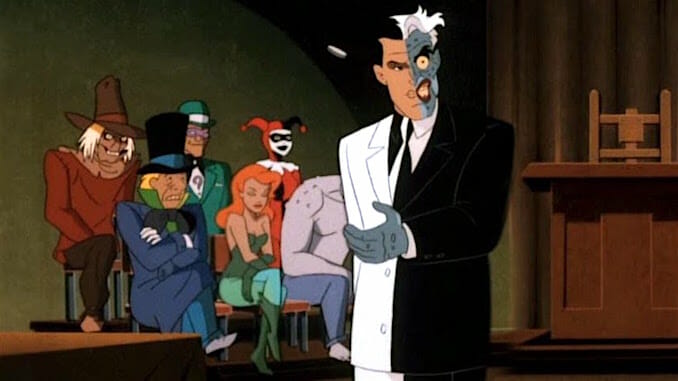Return to Gotham: In The Animated Series, Batman’s Villains Put Him on “Trial”
Photo Courtesy of Fox Kids
Editor’s Note: This year, the iconic Batman: The Animated Series turns 30 years old. “Return to Gotham” is a new monthly column looking back at the cartoon that remains a touchstone of the superhero genre and one of the most iconic portrayals of The Dark Knight.
![]()
As I wrote last month, Batman’s villains are one of the most fascinating aspects of the character himself. If you’re going to adapt the Caped Crusader in any medium, one of the burning questions on everybody’s mind is always what the villains are going to be like: How will a Jack Nicholson Joker be played? How do you tonally accommodate Two-Face into the terminally buttoned-up milieu of a Christopher Nolan film?
In the best cases, the creative teams who bring these Batman stories to life have an understanding of what makes each particular member of his rogues’ gallery an effective foil for Batman. Because every one of his best villains is a twisted reflection of some aspect of the Dark Knight: Two-Face reflects his duality, the Riddler his keen intellect, Mr. Freeze his suppression of his emotion, the Scarecrow his weaponization of fear, Penguin his ill-fitting position within wealth and high society, Catwoman his vigilantism (plus his vow to keep believing girls are gross so he can go punch burglars), and the Joker tests his resolve to live by his nonlethal code. These aspects of his villains hammer at Batman’s vulnerabilities, providing internal conflict that underlies all the bomb threats, heists, and AI-bodysnatching that plots that make up, for instance, your standard-issue Batman: The Animated Series episode.
The show had a dark dedication to framing the stories of many of these villains as tragedies—the episodes abound with stories where the Mad Hatter or Poison Ivy are really the protagonists, and Batman the antagonistic force that succeeds in preventing them from reaching their goals. So while it was definitely a production feat getting nearly every single one of Batman’s villains all into the same episode for “The Trial,” it couldn’t have been much of a stretch for the writers to imagine how they would play out the scenario once it was achieved. (You’ll notice that neither of the “antisocial” foes I wrote about before bother to show up, though, since not even Arkham can hold them. Even in an episode primed to play like a gimmick, the show’s creative leads were unwilling to break continuity).
As the episode opens, Batman finds himself in the crosshairs of Gotham’s newest district attorney, Janet Van Dorn (Stephanie Zimbalist, actually the real-life daughter of Efrem Zimbalist, Jr., Alfred’s voice). The new DA believes Batman is as dangerous as the criminals he rounds up, and tells him so as he gift-wraps a criminal who is pretty clearly a stand-in for The Punisher. When Bruce Wayne goes out to dinner with her to make small talk about how crazy the Dark Knight is, she vanishes, and Batman is captured in his attempt to track her down. The two find themselves in Arkham, where the inmates are running the asylum. Van Dorn is presented with an ultimatum: Take on Batman as a pro bono client as he’s put on trial by his own nemeses and secure an acquittal, or die.
The premise is hilarious, and the voice actors are all having the time of their lives—as will you, if you have a mind to show this episode to a close friend or family member who happens to be a lawyer, and watch as they take issue with absolutely everything: Joker is the openly biased judge; Two-Face is the prosecutor (because he used to be the DA!); members of the jury also provide testimony and boo the defendant. (“Hit him with a rock!!” roars Killer Croc, which is something Batman said while impersonating Killer Croc, revealing true depths to which the Dark Knight has plumbed his opponents’ psyches.)
-

-

-

-

-

-

-

-

-

-

-

-

-

-

-

-

-

-

-

-

-

-

-

-

-

-

-

-

-

-

-

-

-

-

-

-

-

-

-

-








































